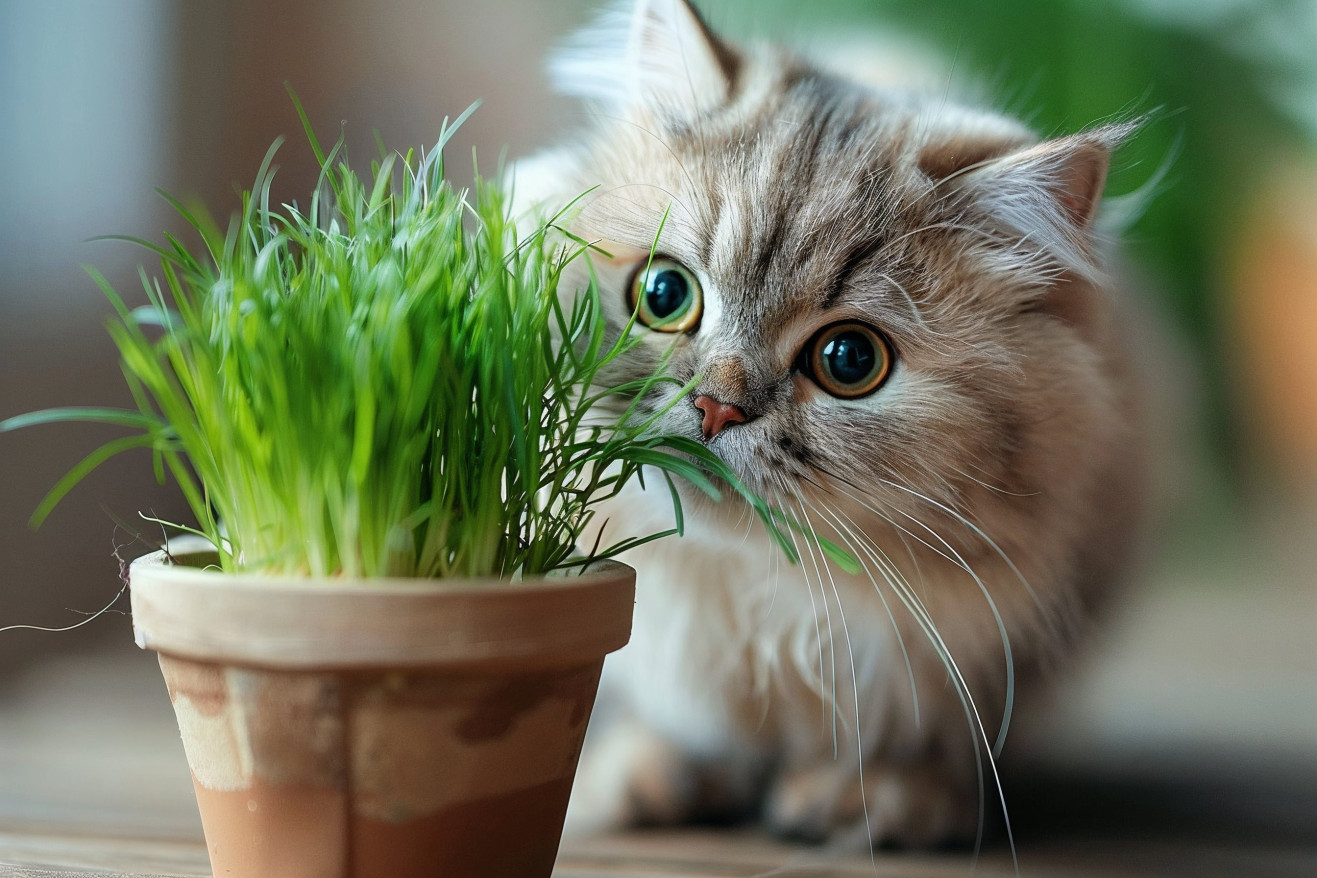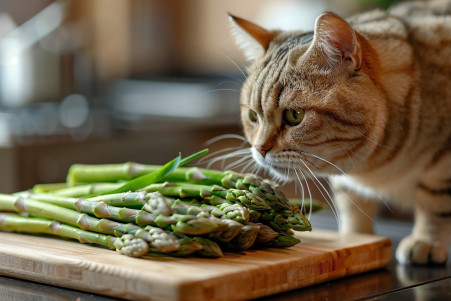Can Cats Eat Wheatgrass? The Benefits and Risks Explained
21 April 2024 • Updated 21 April 2024

Wheatgrass is a popular choice for indoor cats who need a little greenery in their lives, and while it can be beneficial, there are also some things to watch out for. Wheatgrass is safe for cats to eat in moderation and can help with fiber, nutrients, and digestion. However, it should not be used as a substitute for a well-rounded diet of commercial cat food because it does not contain complete proteins and fats. Keep an eye out for any digestive issues, and make sure to serve it fresh.
To help you better understand the potential benefits and downsides of giving your cat wheatgrass, we've looked at information from vets as well as pet parents. By combining scientific research with personal experiences, we hope to help you decide if wheatgrass is the right addition to your cat's diet. We will cover potential concerns, serving sizes, and long-term impacts to help you decide if this popular cat superfood is right for your furry friend.
Can cats eat wheatgrass?
Nutritional Benefits of Wheatgrass for Cats
Wheatgrass is a nutritional powerhouse that is full of vitamins, minerals, and antioxidants that can help improve your cat's health. According to Catster, it is high in vitamins A, E, and C, and carotenoids, including beta-carotene. It also contains important minerals like iron, calcium, and magnesium.
The chlorophyll in wheatgrass is especially important. According to Great Pet Care, chlorophyll helps the body detoxify by purifying the blood and supporting the body's natural detoxification systems. Wheatgrass can also help cats lose weight because it is high in fiber, which can help cats feel full.
In addition, the fiber in wheatgrass can help cats with digestion and hairballs by helping move hair through the digestive system. Anasazi Pet points out that chewing on wheatgrass can also help cats' dental health by removing plaque and massaging the gums, although it should not replace regular dental care.
Wheatgrass' antioxidant properties may also help reduce inflammation, which can help cats' joint health. While more research is needed, the vitamins, minerals, and amino acids in wheatgrass may help reduce inflammation. Because of its many nutrients, wheatgrass can be a great addition to your cat's diet if you introduce it properly. In the next section, we'll discuss how to add wheatgrass to your cat's diet safely and avoid giving them too much.
Moderation and Portion Control: How Much Wheatgrass Can Cats Have?
Although wheatgrass is safe for cats, it should be given in moderation and not be used as a substitute for a well-balanced diet. According to VCA Animal Hospitals, veterinarians suggest that wheatgrass should account for no more than 10% of a cat's daily caloric intake. Overconsumption of wheatgrass can cause gastrointestinal problems, including vomiting, diarrhea, and even intestinal blockages.
In addition, cats should be watched for signs of allergies, including increased scratching, hair loss, and skin irritation. As mentioned by Greg.app, while wheat itself isn't toxic to most cats, some cats can develop allergies to it. A veterinarian can help determine the right amount and frequency of wheatgrass to give a cat based on their age, weight, and health status.
It's important to make sure that wheatgrass is given in the right amounts to cats. With the proper care and advice from a veterinarian, this healthy grass can be a great addition to a cat's diet without causing any gastrointestinal or allergic issues. Next, we'll look at how you can grow wheatgrass at home for your cat.
How to Grow Wheatgrass at Home for Your Cat
Growing wheatgrass at home is a great way to save money and ensure that you always have a fresh, safe supply for your cat. According to 1st Lake, wheatgrass can be grown in containers with drainage holes, using wheat seeds, soil, and water. It can also be grown hydroponically without soil, which is a good option for pet owners.
As PetHelpful notes, the right watering and light conditions are important for the grass to grow and for the grass to retain its nutritional value. If you have multiple containers, you can rotate them so that you always have some that are ready for your cat to eat. The Instructables guide also suggests using a clear plastic container to create a greenhouse effect and keep the soil moist during the germination process.
If you have the right materials and are willing to put in the time and effort, growing wheatgrass at home is a relatively easy way to make sure that your cat has access to a healthy treat. Now, let's look at the differences between fresh and dried wheatgrass to help you decide which is the best option.
Fresh vs. Dried Wheatgrass: Nutritional Value and Safety
Fresh wheatgrass is typically more nutritious than dried wheatgrass, and it contains more of the vitamins, minerals, and antioxidants that are so beneficial. According to Pet Greens, the main difference is that fresh wheatgrass contains more of the valuable chlorophyll, vitamins, and other nutrients than dried wheatgrass.
That said, dried wheatgrass can be a good option for pet parents who don't have the time or resources to grow fresh wheatgrass at home. As King Lou Pets pointed out, the drying process can change the nutritional content, and freeze-drying is the best way to preserve the good stuff.
If you're considering dried wheatgrass, make sure you check it for mold or other contaminants before giving it to your cat. A study published in the PMC found that the method used to dry wheatgrass can make a big difference in its nutritional content. Your vet can help you decide which form of wheatgrass is best and how much to give your cat.
How to Introduce and Feed Wheatgrass to Cats
If you want to introduce wheatgrass to your cat, it’s important to do so carefully and with the guidance of a veterinarian. According to Medium, you should start with very small amounts and watch for any signs of intolerance, including digestive upset or allergies. Make sure the wheatgrass is fresh and organic and hasn’t been treated with pesticides or fertilizers.
You can either grow wheatgrass in a pot and let your cat nibble on it as they please or cut the grass and mix it into their food. As the Instructables guide explains, you can use a clear plastic container as a greenhouse to keep the soil moist in the early stages of growth. It’s also important to store and handle the wheatgrass properly to keep it fresh and free from contaminants.
If you follow the right steps and take the right precautions, you can successfully introduce wheatgrass to your cat as a healthy dietary supplement. However, it’s also important to weigh the potential benefits and drawbacks.
Conclusion: How to Make the Most of Wheatgrass for Cats
Wheatgrass can be a nutritious and beneficial addition to a cat's diet when introduced and consumed in moderation. It provides essential vitamins, minerals, antioxidants, and fiber that can support overall health and well-being. However, overconsumption or improper handling of wheatgrass can lead to digestive issues, allergic reactions, or potential toxicity.
Consulting with a veterinarian and closely monitoring your cat's reaction to wheatgrass is crucial for ensuring its safe and effective use. With proper precautions and moderation, wheatgrass can be a valuable supplement to a balanced, protein-rich diet for cats.


